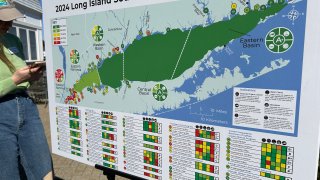
The 2024 report card for Long Island Sound is out and experts say taking the long-term view, this one is fridge worthy.
The Sound scored a clean bill of health in four of the five main basins along the Sound, and even those close to the water on a brisk October Thursday noticed a difference.
“Originally from Western Mass and I recall we used to come to this beach,” said Suzanne Gaudette.
She used to come to Rocky Neck State Park as a kid but hadn’t been back in years. When she arrived Thursday, one of the first things she noticed, was the water.
Get top local stories in Connecticut delivered to you every morning. Sign up for NBC Connecticut's News Headlines newsletter.
“It looks so clean, its clean compared to a lot of beaches I’ve seen,” she said.
The 2024 report card for Long Island sound was full of promising and hopeful news for the body of water.
“To see that statistical improvement in the western part of the Sound is just remarkable,” said Peter Linderoth, with Save the Sound.
Local
According to the report, one of the main takeaways is the improvement in four of the five main basins, with the largest improvement down around Fairfield County and into New York. In the 16 years of testing, there has been remarkable progress, according to Save the Sound.
In total, according to researchers, 98% of the five main basins are getting a B grade or higher.
The struggle point is the Western Narrows, down near New York City and New Jersey. There is still a lot of progress to be made in the western most points, according to the report.
“It’s likely more needs to be done now that the waters of Long Island Sound are warming,” said Lindroth,
He emphasized that even with the progress, they can’t slow down in the face of a changing climate.
“But the progress in the open Long Island Sound doesn’t always translate directly to those smaller bodies of water,” said Jason Krumholz, science advisor to the Unified Water Study and a UConn associate professor.
The data that continues to draw the group's attention is on 57 shallow bays around the sound. There are still struggle points in those bays that need attention to bring down nitrogen levels.
In all, 48% of the studied bays are receiving a C grade or lower, according to the report.
“The bay needs some nitrogen, but too much can become problematic,” Krumholz said.
But more good news from the report: the groups know how to make progress in the trouble spots. Wastewater facility upgrades and emphasis on the health of local watersheds around those bays have made noticeable differences. Save the Sound is putting an emphasis on that work.
Also, the data is getting stronger year over year in the bays as local groups and municipalities continue to gather data in different areas. They only have about 6 years of data specific to many of the bays compared to 16 years of data in the greater Sound.
“All actions matter, no matter where we live in this huge watershed that extends all the way to Canada,” said Lindroth.
He noted there are plenty of steps to take to assist in creating a healthier Sound, including taking stock of landscaping techniques, fertilizer usage, and engaging in local conversations about water quality where you live.
For Gaudette, though she now calls Florida home, she hopes lessons learned from the study of Long Island Sound and techniques to make it healthier will extend coast to coast.
“I think its impressive, I think it’s awesome, hopefully other areas and beaches can do the same across the country,” Gaudette said.



